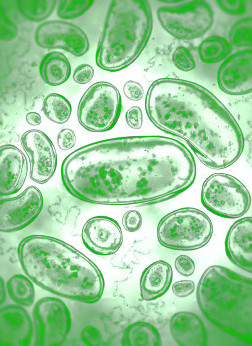Ocean bugs have big influence
 Experts say the collective behaviour of ocean microbes plays big role in climate processes.
Experts say the collective behaviour of ocean microbes plays big role in climate processes.
The tiny marine algae that produce half of the oxygen we breathe everyday have a major role in the release of a gas involved in cloud formation and climate regulation, according to Australian experts.
A team at the University of Technology Sydney (UTS) has quantified the way specific marine bacteria process a key chemical called dimethylsulfoniopropionate (DMSP), which is produced in enormous amount by phytoplankton microbes.
“DMSP is a major nutrient for marine bacteria, it provides a large fraction of their carbon and sulphur requirements,” says Dr Jean-Baptiste Raina from UTS.
“So given the ubiquity and the abundance of DMSP, we expected that these microbial processes would have a significant role in the global sulphur and carbon cycles.”
The team genetically modified a marine bacterium called Ruegeria pomeroyi, causing it to fluoresce when one of two different pathways for processing DMSP was activated, allowing the relative expression of the processes to be analysed under a variety of conditions.
One of the two pathways is called demethylation, and produces carbon and sulphur-based nutrients that can be used to sustain bacterial growth.
The other pathway, called cleavage, produces a gas called dimethylsulfide (DMS), which Dr Raina explains “is the compound that is responsible for the smell of the sea.”
DMS emissions in the ocean create much of the sulphur that enters the atmosphere.
Once in the atmosphere, these sulphur molecules are cloud precursors, enabling the condensation of water molecules, so their concentration in the air affects both rainfall patterns and the overall reflectivity of the atmosphere through cloud formation.
The new study found that concentration of DMSP in their vicinity regulates which pathway the bacteria use. Below a certain concentration, demethylation was dominant, but above a level of about 10 micromoles, the cleavage process dominated.
“What was really surprising to us was, upon experimentation with the engineered bacteria, we found that the concentration of DMSP that leads to upregulation of the cleavage pathway is higher than expected — orders of magnitude higher than the average concentration in the ocean,” MIT graduate student Cherry Gao says.
That suggests that this process hardly takes place under typical ocean conditions, the researchers concluded.
Rather, microscale ‘hotspots’ of elevated DMSP concentration are probably responsible for a disproportionate amount of global DMS production.
These microscale ‘hotspots’ are areas surrounding certain phytoplankton cells where extremely high amounts of DMSP are present at about a thousand times greater than average oceanic concentration.
The study will help researchers understand how these microscopic marine organisms, through their collective behaviour, are affecting global-scale biogeochemical and climatic processes, the researchers say.







 Print
Print